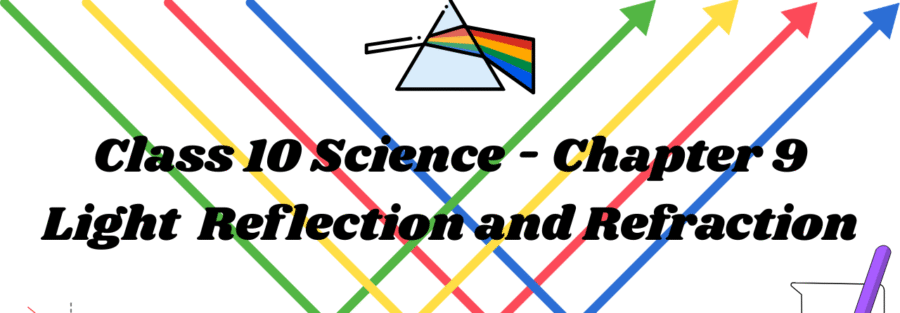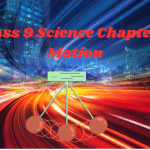Light – Reflection and Refraction – Short Notes
1. Basics of Light
- Light is a form of energy that enables us to see objects.
- It travels in straight lines (rectilinear propagation).
- Speed of light: (3 \times 10^8) m/s in vacuum.
2. Reflection of Light
Bouncing back of light when it strikes a surface.
Laws of Reflection:
- The incident ray, reflected ray, and normal at the point of incidence lie in the same plane.
- Angle of incidence ((i)) = Angle of reflection ((r)).
Types of Reflection:
- Regular Reflection: From smooth surfaces (e.g., mirror), forms clear images.
- Irregular Reflection: From rough surfaces (e.g., paper), scattered light.
3. Spherical Mirrors
Mirrors with curved reflecting surfaces.
Types:
- Concave Mirror: Curved inwards. Converges light.
- Convex Mirror: Curved outwards. Diverges light.
Key Terms:
- Pole (P): Center of the mirror.
- Center of Curvature (C): Center of the sphere.
- Radius of Curvature (R): Distance from C to P.
- Focus (F): Point where parallel rays converge (concave) or appear to diverge (convex).
- Focal Length (f): Distance from P to F. (f = \frac{R}{2}).
4. Image Formation by Spherical Mirrors
Concave Mirror:
- Object at Infinity: Image at F, real, inverted, point-sized.
- Beyond C: Image between F and C, real, inverted, diminished.
- At C: Image at C, real, inverted, same size.
- Between C and F: Image beyond C, real, inverted, enlarged.
- At F: Image at infinity, real, inverted, highly enlarged.
- Between P and F: Image behind mirror, virtual, erect, enlarged.
Convex Mirror:
- Always forms: Virtual, erect, diminished image behind mirror.
5. Mirror Formula & Magnification
- Mirror Formula: (\frac{1}{f} = \frac{1}{v} + \frac{1}{u})
- (f): focal length, (v): image distance, (u): object distance.
- Magnification ((m)): (m = \frac{h_i}{h_o} = -\frac{v}{u})
- (h_i): image height, (h_o): object height.
- Sign Convention:
- Object distance ((u)): always negative.
- Focal length ((f)): negative for concave, positive for convex.
- Image distance ((v)): negative for real image, positive for virtual image.
6. Refraction of Light
Bending of light when it passes from one medium to another.
Cause: Change in speed of light.
- Laws of Refraction:
- Incident ray, refracted ray, and normal lie in the same plane.
- Snell’s Law: (\frac{\sin i}{\sin r} = \text{constant} = n_{21})
- (n_{21}): refractive index of medium 2 w.r.t. medium 1.
Refractive Index ((n)):
- (n = \frac{\text{speed of light in vacuum}}{\text{speed of light in medium}} = \frac{c}{v})
- (n_{\text{air}} \approx 1), (n_{\text{water}} = 1.33), (n_{\text{glass}} = 1.5)
7. Spherical Lenses
Transparent material with curved surfaces.
Types:
- Convex Lens: Thicker in center. Converges light.
- Concave Lens: Thinner in center. Diverges light.
Key Terms:
- Optical Center (O): Center of the lens.
- Principal Axis: Line through O.
- Focus (F): Point where parallel rays converge (convex) or appear to diverge (concave).
- Focal Length (f): Distance from O to F.
8. Image Formation by Lenses
Convex Lens:
- Object at Infinity: Image at F, real, inverted, point-sized.
- Beyond 2F: Image between F and 2F, real, inverted, diminished.
- At 2F: Image at 2F, real, inverted, same size.
- Between F and 2F: Image beyond 2F, real, inverted, enlarged.
- At F: Image at infinity, real, inverted, highly enlarged.
- Between O and F: Image on same side, virtual, erect, enlarged.
Concave Lens:
- Always forms: Virtual, erect, diminished image on same side.
9. Lens Formula & Magnification
- Lens Formula: (\frac{1}{f} = \frac{1}{v} – \frac{1}{u})
- Magnification ((m)): (m = \frac{h_i}{h_o} = \frac{v}{u})
- Sign Convention:
- Object distance ((u)): always negative.
- Focal length ((f)): positive for convex, negative for concave.
- Image distance ((v)): positive for real image, negative for virtual image.
10. Power of a Lens
- Power ((P)): (P = \frac{1}{f}) (where (f) is in meters).
- Unit: Dioptre (D).
- Convex lens: +ve power, Concave lens: -ve power.
Simple Text-Based Diagrams
1. Reflection:
Incident
Ray
\
\
\
Normal \ i r
| \ /
| \ /
| \/
|-----------
Surface2. Concave Mirror Ray Diagram (Object beyond C):
Object
| \
| \
| \
| \
| \
| \
| \
| \
C F P3. Convex Lens Ray Diagram (Object beyond 2F):
Object
| \
| \
| \
| \
| \
| \
| \
2F F OQuick Revision Table: Mirror vs. Lens
| Feature | Concave Mirror | Convex Lens |
|---|---|---|
| Type | Converging | Converging |
| Image | Real/Virtual | Real/Virtual |
| Focal Length | Negative | Positive |
Exam Tips:
- Practice ray diagrams for all cases.
- Use sign convention correctly in numericals.
- Remember formulas: Mirror: (\frac{1}{f} = \frac{1}{v} + \frac{1}{u}), Lens: (\frac{1}{f} = \frac{1}{v} – \frac{1}{u}).
कक्षा 10 विज्ञान – अध्याय 9: प्रकाश-परावर्तन तथा अपवर्तन – संक्षिप्त नोट्स
1. प्रकाश का परिचय
- प्रकाश ऊर्जा का एक रूप है जो हमें वस्तुओं को देखने में सक्षम बनाता है।
- यह सीधी रेखाओं में यात्रा करता है (रेखीय संचरण)।
- निर्वात में प्रकाश की चाल: (3 \times 10^8) m/s
2. प्रकाश का परावर्तन
जब प्रकाश किसी सतह पर गिरता है तो वापस लौटने की घटना।
परावर्तन के नियम:
- आपतित किरण, परावर्तित किरण और आपतन बिंदु पर अभिलंब तीनों एक ही तल में होते हैं।
- आपतन कोण ((i)) = परावर्तन कोण ((r))।
परावर्तन के प्रकार:
- नियमित परावर्तन: चिकनी सतहों से (जैसे दर्पण), स्पष्ट प्रतिबिंब बनते हैं।
- अनियमित परावर्तन: खुरदरी सतहों से (जैसे कागज), प्रकाश बिखर जाता है।
3. गोलीय दर्पण
वक्रित परावर्तक सतह वाले दर्पण।
प्रकार:
- अवतल दर्पण: अंदर की ओर वक्रित। प्रकाश को अभिसारित करता है।
- उत्तल दर्पण: बाहर की ओर वक्रित। प्रकाश को अपसारित करता है।
मुख्य शब्द:
- ध्रुव (P): दर्पण का केंद्र।
- वक्रता केंद्र (C): गोले का केंद्र।
- वक्रता त्रिज्या (R): C से P की दूरी।
- फोकस (F): वह बिंदु जहाँ समांतर किरणें मिलती हैं (अवतल) या मिलती हुई प्रतीत होती हैं (उत्तल)।
- फोकस दूरी (f): P से F की दूरी। (f = \frac{R}{2}).
4. गोलीय दर्पणों द्वारा प्रतिबिंब बनना
अवतल दर्पण:
- वस्तु अनंत पर: प्रतिबिंब F पर, वास्तविक, उल्टा, बिंदु आकार।
- C से परे: प्रतिबिंब F और C के बीच, वास्तविक, उल्टा, छोटा।
- C पर: प्रतिबिंब C पर, वास्तविक, उल्टा, समान आकार।
- C और F के बीच: प्रतिबिंब C से परे, वास्तविक, उल्टा, बड़ा।
- F पर: प्रतिबिंब अनंत पर, वास्तविक, उल्टा, अत्यधिक बड़ा।
- P और F के बीच: प्रतिबिंब दर्पण के पीछे, आभासी, सीधा, बड़ा।
उत्तल दर्पण:
- हमेशा बनाता है: आभासी, सीधा, छोटा प्रतिबिंब दर्पण के पीछे।
5. दर्पण सूत्र एवं आवर्धन
- दर्पण सूत्र: (\frac{1}{f} = \frac{1}{v} + \frac{1}{u})
- (f): फोकस दूरी, (v): प्रतिबिंब दूरी, (u): वस्तु दूरी।
- आवर्धन ((m)): (m = \frac{h_i}{h_o} = -\frac{v}{u})
- (h_i): प्रतिबिंब की ऊँचाई, (h_o): वस्तु की ऊँचाई।
- चिह्न परिपाटी:
- वस्तु दूरी ((u)): सदैव ऋणात्मक।
- फोकस दूरी ((f)): अवतल के लिए ऋणात्मक, उत्तल के लिए धनात्मक।
- प्रतिबिंब दूरी ((v)): वास्तविक प्रतिबिंब के लिए ऋणात्मक, आभासी के लिए धनात्मक।
6. प्रकाश का अपवर्तन
जब प्रकाश एक माध्यम से दूसरे माध्यम में जाता है तो उसके मुड़ने की घटना।
कारण: प्रकाश की चाल में परिवर्तन।
- अपवर्तन के नियम:
- आपतित किरण, अपवर्तित किरण और अभिलंब एक ही तल में होते हैं।
- स्नेल का नियम: (\frac{\sin i}{\sin r} = \text{constant} = n_{21})
- (n_{21}): माध्यम 2 का माध्यम 1 के सापेक्ष अपवर्तनांक।
अपवर्तनांक ((n)):
- (n = \frac{\text{निर्वात में प्रकाश की चाल}}{\text{माध्यम में प्रकाश की चाल}} = \frac{c}{v})
- (n_{\text{वायु}} \approx 1), (n_{\text{जल}} = 1.33), (n_{\text{कांच}} = 1.5)
7. गोलीय लेंस
वक्रित सतहों वाला पारदर्शी पदार्थ।
प्रकार:
- उत्तल लेंस: बीच में मोटा। प्रकाश को अभिसारित करता है।
- अवतल लेंस: बीच में पतला। प्रकाश को अपसारित करता है।
मुख्य शब्द:
- प्रकाशिक केंद्र (O): लेंस का केंद्र।
- मुख्य अक्ष: O से गुजरने वाली रेखा।
- फोकस (F): वह बिंदु जहाँ समांतर किरणें मिलती हैं (उत्तल) या मिलती हुई प्रतीत होती हैं (अवतल)।
- फोकस दूरी (f): O से F की दूरी।
8. लेंसों द्वारा प्रतिबिंब बनना
उत्तल लेंस:
- वस्तु अनंत पर: प्रतिबिंब F पर, वास्तविक, उल्टा, बिंदु आकार।
- 2F से परे: प्रतिबिंब F और 2F के बीच, वास्तविक, उल्टा, छोटा।
- 2F पर: प्रतिबिंब 2F पर, वास्तविक, उल्टा, समान आकार।
- F और 2F के बीच: प्रतिबिंब 2F से परे, वास्तविक, उल्टा, बड़ा。
- F पर: प्रतिबिंब अनंत पर, वास्तविक, उल्टा, अत्यधिक बड़ा。
- O और F के बीच: प्रतिबिंब उसी ओर, आभासी, सीधा, बड़ा।
अवतल लेंस:
- हमेशा बनाता है: आभासी, सीधा, छोटा प्रतिबिंब उसी ओर।
9. लेंस सूत्र एवं आवर्धन
- लेंस सूत्र: (\frac{1}{f} = \frac{1}{v} – \frac{1}{u})
- आवर्धन ((m)): (m = \frac{h_i}{h_o} = \frac{v}{u})
- चिह्न परिपाटी:
- वस्तु दूरी ((u)): सदैव ऋणात्मक।
- फोकस दूरी ((f)): उत्तल के लिए धनात्मक, अवतल के लिए ऋणात्मक।
- प्रतिबिंब दूरी ((v)): वास्तविक प्रतिबिंब के लिए धनात्मक, आभासी के लिए ऋणात्मक।
10. लेंस की क्षमता
- क्षमता ((P)): (P = \frac{1}{f}) (जहाँ (f) मीटर में है)।
- मात्रक: डायोप्टर (D)।
- उत्तल लेंस: +ve क्षमता, अवतल लेंस: -ve क्षमता।
आरेखों के लिए स्मरणीय बिंदु
- अवतल दर्पण:
- फोकस से गुजरने वाली किरण परावर्तन के बाद मुख्य अक्ष के समांतर हो जाती है।
- वक्रता केंद्र से गुजरने वाली किरण वापस उसी मार्ग से लौटती है।
- उत्तल लेंस:
- फोकस से गुजरने वाली किरण अपवर्तन के बाद मुख्य अक्ष के समांतर हो जाती है।
- प्रकाशिक केंद्र से गुजरने वाली किरण बिना मुड़े सीधी निकल जाती है।
परीक्षा सुझाव:
- सभी स्थितियों के किरण आरेख अभ्यास से बनाएं।
- सूत्रों में चिह्न परिपाटी का सही प्रयोग करें।
- आवर्धन के सूत्र याद रखें।



